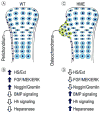The pathogenic roles of heparan sulfate deficiency in hereditary multiple exostoses
- PMID: 29277722
- PMCID: PMC6015767
- DOI: 10.1016/j.matbio.2017.12.011
The pathogenic roles of heparan sulfate deficiency in hereditary multiple exostoses
Abstract
Heparan sulfate (HS) is an essential component of cell surface and matrix proteoglycans (HS-PGs) that include syndecans and perlecan. Because of their unique structural features, the HS chains are able to specifically interact with signaling proteins -including bone morphogenetic proteins (BMPs)- via their HS-binding domain, regulating protein availability, distribution and action on target cells. Hereditary Multiple Exostoses (HME) is a rare pediatric disorder linked to germline heterozygous loss-of-function mutations in EXT1 or EXT2 that encode Golgi-resident glycosyltransferases responsible for HS synthesis, resulting in a systemic HS deficiency. HME is characterized by cartilaginous/bony tumors -called osteochondromas or exostoses- that form within perichondrium in long bones, ribs and other elements. This review examines most recent studies in HME, framing them in the context of classic studies. New findings show that the spectrum of EXT mutations is larger than previously realized and the clinical complications of HME extend beyond the skeleton. Osteochondroma development requires a somatic "second hit" that would complement the germline EXT mutation to further decrease HS production and/levels at perichondrial sites of osteochondroma induction. Cellular studies have shown that the steep decreases in local HS levels: derange the normal homeostatic signaling pathways keeping perichondrium mesenchymal; cause excessive BMP signaling; and provoke ectopic chondrogenesis and osteochondroma formation. Data from HME mouse models have revealed that systemic treatment with a BMP signaling antagonist markedly reduces osteochondroma formation. In sum, recent studies have provided major new insights into the molecular and cellular pathogenesis of HME and the roles played by HS deficiency. These new insights have led to the first ever proof-of-principle demonstration that osteochondroma formation is a druggable process, paving the way toward the creation of a clinically-relevant treatment.
Keywords: Drug treatment; EXT1; EXT2; Heparan sulfate; Heparan sulfate proteoglycans; Hereditary multiple Exostoses; Signaling proteins and pathways.
Copyright © 2018. Published by Elsevier B.V.
Figures


Similar articles
-
Unsuspected osteochondroma-like outgrowths in the cranial base of Hereditary Multiple Exostoses patients and modeling and treatment with a BMP antagonist in mice.PLoS Genet. 2017 Apr 26;13(4):e1006742. doi: 10.1371/journal.pgen.1006742. eCollection 2017 Apr. PLoS Genet. 2017. PMID: 28445472 Free PMC article.
-
Osteochondroma formation is independent of heparanase expression as revealed in a mouse model of hereditary multiple exostoses.J Orthop Res. 2022 Oct;40(10):2391-2401. doi: 10.1002/jor.25260. Epub 2022 Jan 22. J Orthop Res. 2022. PMID: 34996123 Free PMC article.
-
Heparan sulfate antagonism alters bone morphogenetic protein signaling and receptor dynamics, suggesting a mechanism in hereditary multiple exostoses.J Biol Chem. 2018 May 18;293(20):7703-7716. doi: 10.1074/jbc.RA117.000264. Epub 2018 Apr 5. J Biol Chem. 2018. PMID: 29622677 Free PMC article.
-
Hereditary Multiple Exostoses: New Insights into Pathogenesis, Clinical Complications, and Potential Treatments.Curr Osteoporos Rep. 2017 Jun;15(3):142-152. doi: 10.1007/s11914-017-0355-2. Curr Osteoporos Rep. 2017. PMID: 28466453 Free PMC article. Review.
-
Heparan sulfate in skeletal development, growth, and pathology: the case of hereditary multiple exostoses.Dev Dyn. 2013 Sep;242(9):1021-32. doi: 10.1002/dvdy.24010. Epub 2013 Jul 29. Dev Dyn. 2013. PMID: 23821404 Free PMC article. Review.
Cited by
-
A novel mutation in ext2 caused hereditary multiple exostoses through reducing the synthesis of heparan sulfate.Genet Mol Biol. 2021 May 21;44(2):e20200334. doi: 10.1590/1678-4685-GMB-2020-0334. eCollection 2021. Genet Mol Biol. 2021. PMID: 34042151 Free PMC article.
-
Specific functions of Exostosin-like 3 (EXTL3) gene products.Cell Mol Biol Lett. 2020 Aug 20;25:39. doi: 10.1186/s11658-020-00231-y. eCollection 2020. Cell Mol Biol Lett. 2020. PMID: 32843889 Free PMC article. Review.
-
Identification of Two Novel Frameshift Mutations in Exostosin 1 in Two Families with Multiple Osteochondromas.Mol Syndromol. 2021 Apr;12(2):96-100. doi: 10.1159/000512856. Epub 2021 Feb 16. Mol Syndromol. 2021. PMID: 34012378 Free PMC article.
-
Hereditary multiple exostoses: are there new plausible treatment strategies?Expert Opin Orphan Drugs. 2018;6(6):385-391. doi: 10.1080/21678707.2018.1483232. Epub 2018 Jun 7. Expert Opin Orphan Drugs. 2018. PMID: 31448184 Free PMC article.
-
Chondrodysplasias With Multiple Dislocations Caused by Defects in Glycosaminoglycan Synthesis.Front Genet. 2021 Jun 16;12:642097. doi: 10.3389/fgene.2021.642097. eCollection 2021. Front Genet. 2021. PMID: 34220933 Free PMC article. Review.
References
-
- Bishop JR, Schuksz M, Esko JD. Heparan sulphate proteoglycans fine-tune mammalian physiology. nature. 2007;446:1030–1037. - PubMed
-
- Lamanna WC, Kalus I, Pavda M, Baldwin RJ, Merry CLR, Dierks T. The heparanome - The enigma of encoding and decoding heparan sulfate sulfation. J Biotechnology. 2007;129:290–307. - PubMed
-
- Dhoot GK, Gustafsson MK, Ai X, Sun w, Standiford DM, Emerson CP. Regulation of Wnt signaling and embryo patterning by an extracellular sulfatase. Science. 2001;293:1663–1666. - PubMed
Publication types
MeSH terms
Substances
Grants and funding
LinkOut - more resources
Full Text Sources
Other Literature Sources
Miscellaneous

